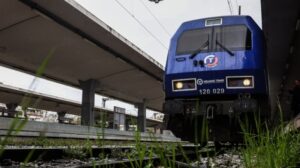Greece is proceeding with the upgrade of its railway network, on the basis of a comprehensive investment plan for sustainable and resilient infrastructure. This was stated by Infrastructure and Transport Minister Christos Staikouras, noting that an important step is the securing of more than half a billion Euros (518,865,020 Euros) of EU funds for the co-financing of rail projects, to be implemented over the next four years, coming from the latest call of the Cohesion Fund envelope of the Connecting Europe Facility (CEF II).
The approved proposals fill gaps in the main axis Patras – Athens – Thessaloniki – Idomeni / Promahonas (PATHE/P) and concern the following projects:
1. Upgrading of the railway line Thessaloniki – Premahonas on the section Mouries – Promahonas (112.075.200 Euro).
2. Upgrading of the railway line SKA – Oinoi (192.142.704 Euro).
3. Upgrading of the Pythio – Ormenio railway line (ERGOSE) (186.667.916,75 Euro).
4. New signalling and telecommand system (ETCS L1) on the SKA-Kiato section (27.979.200 Euro).
This amount is complemented with national resources, creating opportunities for employment and unlocking the development entropy of the country’s regions. Particular emphasis was placed on cross-border connectivity with Bulgaria and the development of a multimodal transport corridor with the countries of Central Europe, the Baltic Sea and Ukraine.
In particular, on the occasion of the approval of four (4) railway projects for co-financing from the Connecting Europe Facility II (CEF II), Minister of Infrastructure and Transport Christos Staikouras said: “The approval of the four projects, although it is a recognition of the Greek Government’s continuous and unremitting effort to revitalize the country’s railway network and overcome chronic pathologies of the system, is only the beginning of the journey of the 20-year investment strategy in the railway. With the vision of the triptych Upgrade – Safety – Development, a draft proposal is being prepared immediately to complete the Alexandroupoli – Ormenio line and connect strategic ports of the country with the PATHE/P. The aim is to claim new co-financing within 2025 for the development of the network by 2030, based on the requirements set by the new regulation for the development of the Trans-European Transport Network (EU) 2024/1679 and based on the resilience of the infrastructure. The revitalization of the country’s rail transport requires the formation of a sustainable, modern, fast and absolutely safe network, in full interoperability with the corresponding European networks, capable of becoming an integral and key arm of the Trans-European Transport Network in South-Eastern Europe and attracting international flows.”
Ask me anything
Explore related questions





